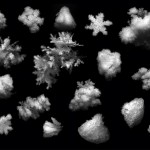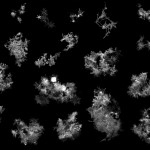SALT LAKE CITY — University of Utah researchers developed a high-speed camera system that spent the past two winters photographing snowflakes in 3-D as they fell – and they don’t look much like those perfect-but-rare snowflakes often seen in photos.
Flake photos
“Until our device, there was no good instrument for automatically photographing the shapes and sizes of snowflakes in free-fall,” says Tim Garrett, an associate professor of atmospheric sciences. “We are photographing these snowflakes completely untouched by any device, as they exist naturally in the air.”
Snowflakes in traditional photographs “tend to be of a particular type that conveniently lies flat on a microscope slide, where a camera can get them perfectly in focus, and the photographer can take the time to get the light exactly right,” he says.
“These perfectly symmetric, six-sided snowflakes, while beautiful, are exceedingly rare – perhaps one-in-a-thousand at the most,” says Garrett.
NASA and the U.S. Army helped fund development of the camera, and the National Science Foundation funded the observations. Garrett says the goal is to improve computer simulations of falling snow and how it interacts with radar. That should help improve the use of radar for weather and snowpack forecasting, and reveal more about how snowy weather can degrade microwave (radar) communications.
Multi-Angle Snowflake Camera
With help from the University of Utah’s Technology Commercialization Office, Garrett and Cale Fallgatter – a 2008 master’s graduate in mechanical engineering – formed a spinoff company, Fallgatter Technologies, to make the new camera system, known as the MASC, for Multi-Angle Snowflake Camera, for which a patent is pending.
The device – under development for three years – includes three, industrial-grade, high-speed cameras: two 1.2-megapixel cameras and a 5-megapixel camera, plus two sets of two motion sensors to measure the speed of falling snowflakes.
“For forecasting the weather, fall speed is the thing that matters,” Garrett says. “The weather models right now do OK at simulating clouds, but they are struggling to accurately reproduce precipitation: rain or snow, but particularly snow. The problem is that we do not have a very good sense for how the sizes and shapes of snow particles relate to how fast they fall. This is important because the lifetime of a storm, and where exactly it snows, depends greatly on how fast snow precipitates.”
Why care about snowflakes?
“Snowflakes are beautiful and fascinating, and truly no two are alike,” Garrett says. “This complexity almost makes them worth studying in their own right. But also, there are very serious practical reasons why we need to understand snow better.”
Falling snow affects both microwave communications and weather-forecasting radar (which uses microwaves), yet “the big problem is there is a very poor sense of how microwave radiation interacts with complex snowflake shapes,” Garrett says.
Weather forecasting
Weather models used in forecasting now invoke complicated formulas to simulate precipitation – “how cloud droplets turn into snow, snow turns into graupel and all the complicated ways in which particles in a cloud can change in size, shape and fall speed as a storm progresses,” Garrett says. “There has been a huge amount of research into improving these formulas, but their accuracy is limited by how well we are able to measure snow and how fast it falls.”
Garrett says today’s weather forecasts still use snowflake research done meticulously by hand in the 1970s in the Pacific Northwest’s Cascade Range. Snowflake fall speed was measured, and the flakes then were collected on plastic wrap, photographed, and melted to determine their mass.
“These early researchers got only a few hundred images over two years because they had to collect each snowflake individually by hand,” Garrett says. “Our snowflake camera can automatically collect thousands of snowflake photographs in a single night.”
(Photos: Tim Garrett)
















Thanks so much always knew there was a reason other then making snow angels that I loved about snow!
Maybe a new, high tech snow shovel will be devoloped as this research continues!
cool this is all i need for my poster.😁